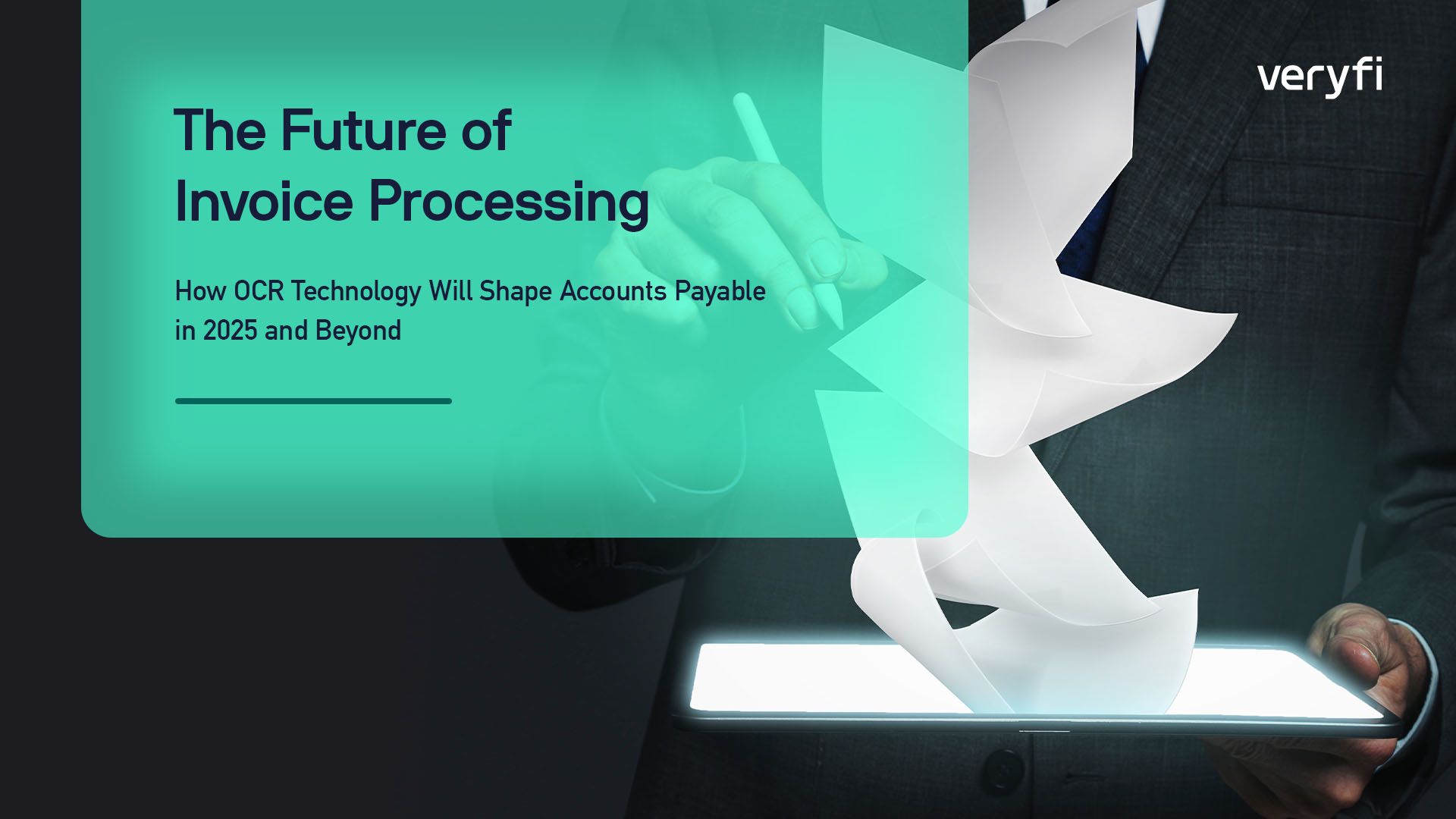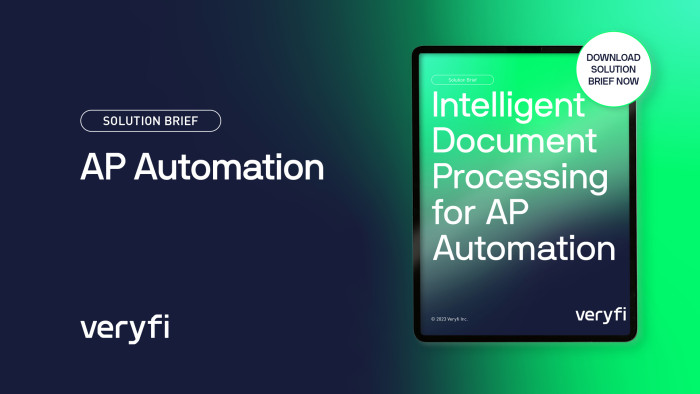Introduction
The accounts payable landscape is experiencing a seismic shift as organizations worldwide embrace digital transformation to streamline their financial operations. The accounts payable automation market is projected to grow from USD 3,041.52 million in 2024 to USD 8,106.74 million by 2034, representing a robust CAGR of 10.30% (Future Market Insights). At the heart of this transformation lies Optical Character Recognition (OCR) technology, which has evolved from simple text recognition to sophisticated AI-powered data extraction systems that can process invoices with unprecedented speed and accuracy.
The driving force behind this market expansion is clear: organizations are seeking to eliminate manual handling of accounts receivable processes, such as creating and sending invoices, tracking payments, resolving disputes, and maintaining customer records (MarketsandMarkets). Modern OCR technology, particularly AI-native platforms like Veryfi’s lightning-fast APIs that transform unstructured documents into structured data in just 3-5 seconds, represents the future of invoice processing automation.
The Current State of Invoice Processing Challenges
The Complexity of Modern Invoice Management
Invoice processing remains one of the most challenging aspects of financial operations for businesses across all industries. Invoices can come in various formats including paper, email, PDFs, or electronic data interchange (EDI), each containing structured and unstructured data (Unstract). This diversity creates significant obstacles for traditional processing methods.
The challenges are multifaceted and include the variety of invoice formats, specialized terminology or codes they contain, inconsistent data fields, multilingual and regional differences, variable invoice image quality, unstructured and semi-structured invoice data, and manual errors (Artsyl Technologies). These complexities have historically made invoice processing a tedious and time-consuming task for businesses, often requiring significant manual intervention and prone to human error.
The Cost of Manual Processing
Traditional manual invoice processing methods are not only time-consuming but also expensive and error-prone. Organizations that rely on manual data entry face several critical issues:
- Time inefficiency: Manual processing can take hours or even days for complex invoices
- High error rates: Human data entry is susceptible to mistakes that can lead to payment delays or disputes
- Scalability limitations: Manual processes cannot easily scale with business growth
- Compliance risks: Manual handling increases the risk of regulatory non-compliance
Optical Character Recognition (OCR) technology addresses these challenges by converting different types of documents, such as scanned paper documents, PDFs, or images captured by a digital camera, into editable and searchable data (Veryfi OCR History). This transformation enables businesses to automate their invoice processing workflows significantly.
The Evolution of OCR Technology in Invoice Processing
From Simple Text Recognition to Intelligent Data Extraction
The history of OCR technology traces back to the late 1800s, with the first OCR devices developed in the 1920s by innovators like Emanuel Goldberg for numeric recognition (Veryfi OCR Technology). However, the technology has evolved dramatically from these early template-matching systems to today’s sophisticated AI-powered platforms.
In the 1950s, the first OCR machines capable of recognizing letters were developed using template matching, a process that relied on pre-programmed letter templates (Veryfi OCR Technology). Modern OCR technology has transcended these limitations, incorporating machine learning algorithms and artificial intelligence to understand context, handle multiple languages, and extract complex data relationships.
The AI Revolution in Document Processing
Artificial Intelligence has revolutionized invoice data extraction, transforming it from a traditionally tedious and time-consuming task into an automated, accurate process (Artsyl Technologies). AI-powered invoice data extraction has gained significant popularity in recent years due to its ability to automate the process and improve accuracy significantly.
Large Language Models (LLMs) are now being used to handle the complex challenges involved in processing invoices (Unstract). These advanced systems can understand context, interpret varying formats, and extract meaningful data even from poorly structured documents.
Market Trends Driving OCR Adoption in 2025 and Beyond
Explosive Market Growth Projections
The AI for Invoice Management Market presents one of the most compelling growth stories in the business automation sector. The market size is projected to grow from USD 2.8 billion in 2024 to USD 47.1 billion by 2034, representing an impressive CAGR of 32.6% (Market.us). This explosive growth reflects the increasing recognition of AI-powered OCR solutions as essential business infrastructure.
In 2024, North America held a significant lead in the AI for Invoice Management market, capturing over 43.6% of the global share and generating USD 1.2 billion in revenue (Market.us). The U.S. market significantly contributed to the North American market, exhibiting a size of USD 1.05 billion, demonstrating the mature adoption of these technologies in established markets.
Key Market Drivers
Several factors are driving this unprecedented growth in OCR-powered invoice processing:
- Digital Transformation Initiatives: Organizations worldwide are adopting digital transformation initiatives, driving the growth of the AP automation market (Future Market Insights)
- Operational Efficiency Demands: Benefits of AP automation include streamlined operations, improved efficiency, and reduced manual errors (Future Market Insights)
- Cost Reduction Pressures: Organizations seek to reduce operational costs while maintaining accuracy and compliance
- Scalability Requirements: Growing businesses need solutions that can scale with their operations
Advanced OCR Features Shaping the Future
Multi-Language and Multi-Currency Support
Modern OCR platforms are breaking down geographical barriers by supporting multiple languages and currencies. Advanced solutions like Veryfi’s APIs support 91 currencies and 38 languages, enabling global businesses to process invoices from suppliers worldwide without manual intervention. This capability is crucial as businesses expand internationally and deal with increasingly diverse supplier networks.
The ability to handle multilingual and regional differences in invoice processing represents a significant advancement over traditional OCR systems (Artsyl Technologies). This feature eliminates the need for separate processing workflows for different regions and languages, streamlining global operations.
Contextual Data Extraction
Next-generation OCR platforms like Veryfi’s ∀Docs are designed to extract data in context, using contextual clues from the rest of the document to paint a precise data extraction story (Veryfi ∀Docs). This contextual understanding represents a significant leap forward from traditional template-based extraction methods.
The tool is powered by proprietary machine learning models, trained on a vast corpus of documents, enabling it to understand document structure and relationships between different data elements (Veryfi ∀Docs). This approach ensures higher accuracy rates and reduces the need for manual verification.
Real-Time Processing Capabilities
Speed has become a critical differentiator in OCR technology. Modern platforms can process invoices in real-time, with some solutions achieving processing times of 3-5 seconds per document. This speed enables businesses to make faster payment decisions, improve supplier relationships, and maintain better cash flow management.
The emphasis on speed doesn’t compromise accuracy. Advanced OCR platforms maintain enterprise-grade accuracy while delivering lightning-fast processing times, representing the ideal combination for modern business needs.
Integration with Enterprise Systems
ERP Integration and Two-Way Matching
Enterprise Resource Planning (ERP) software integration has become essential for comprehensive invoice processing automation. ERP systems help businesses streamline their operations, reduce costs, and improve efficiency by automating many of their core business functions (Veryfi ERP Understanding). The integration of OCR technology with ERP systems creates powerful automation workflows.
Two-way matching represents a critical application of OCR technology in enterprise environments. Two-way matching is an accounting process that compares the purchase order (PO) and the vendor’s invoice before approving payment (Veryfi Two-Way Matching). The two key documents in this process are the purchase order and the invoice, and OCR technology can extract relevant data from both documents automatically.
The true potential of two-way matching is unlocked when combined with Optical Character Recognition (OCR) technology (Veryfi Two-Way Matching). This combination enables businesses to prevent accounting errors through automating two-way matching processes using fast, accurate, and secure AI-driven data extraction.
Industry-Specific Applications
Different industries have unique requirements for invoice processing, and modern OCR platforms are adapting to meet these specific needs:
Manufacturing: One industry that has particularly benefited from the adoption of ERP software is manufacturing (Veryfi ERP Understanding). Manufacturing companies often deal with complex supply chains and multiple suppliers, making automated invoice processing essential.
Healthcare, Retail, and Finance: Businesses in sectors such as healthcare, retail, and finance have also adopted ERP software to help them manage their operations more effectively (Veryfi ERP Understanding). Each sector has specific compliance requirements and processing needs that modern OCR platforms can address.
Recent Technological Advancements
Product Development Innovations
The OCR industry continues to evolve rapidly, with significant advancements being made regularly. In the fall of 2023, major OCR providers made significant efforts to increase the precision and efficiency of data extractions across all their OCR APIs (Veryfi Product Developments). These improvements included new fields introduced for the Receipts & Invoices API and multiple model releases focused on extracting bank details from invoices and extracting data from CPG receipts.
These continuous improvements demonstrate the dynamic nature of the OCR industry and the commitment to enhancing accuracy and functionality. The focus on specific use cases, such as bank detail extraction and CPG receipt processing, shows how OCR technology is becoming more specialized and targeted.
AI-Powered Enhancements
Modern OCR platforms are incorporating advanced AI capabilities that go beyond simple text recognition. These enhancements include:
- Fraud Detection: AI algorithms can identify potentially fraudulent documents
- Data Validation: Automatic validation of extracted data against business rules
- Learning Capabilities: Systems that improve accuracy over time through machine learning
- Exception Handling: Intelligent routing of problematic documents for human review
Security and Compliance Considerations
Enterprise-Grade Security
As invoice processing involves sensitive financial data, security has become a paramount concern for organizations evaluating OCR solutions. Modern platforms implement enterprise-grade security measures, including SOC 2 Type II compliance, to ensure data protection throughout the processing pipeline.
The importance of security cannot be overstated, particularly as businesses process increasing volumes of sensitive financial documents. Organizations need assurance that their OCR providers maintain the highest security standards and comply with relevant regulations.
Compliance Automation
OCR technology is also helping organizations maintain compliance with various financial regulations. Automated data extraction ensures consistent processing methods, creates audit trails, and reduces the risk of human error that could lead to compliance violations.
Implementation Strategies and Best Practices
Choosing the Right OCR Platform
When selecting an OCR platform for invoice processing, organizations should consider several key factors:
| Factor | Importance | Considerations |
|---|---|---|
| Accuracy | Critical | Look for platforms with enterprise-grade accuracy and day-1-ready performance |
| Speed | High | Processing times should be measured in seconds, not minutes |
| Language Support | Variable | Consider your global supplier base and required language coverage |
| Integration | Critical | Ensure compatibility with existing ERP and accounting systems |
| Security | Critical | Verify compliance certifications and security protocols |
| Scalability | High | Platform should handle growing document volumes |
Implementation Timeline and Considerations
Successful OCR implementation requires careful planning and execution. Organizations should expect implementation timelines that can range from weeks to months, depending on the complexity of their requirements and existing systems.
Case studies demonstrate that rapid implementation is possible with the right approach. For example, Latium USA and its Four Seasons Family of Companies implemented advanced OCR solutions to gain financial visibility and control their expenses within just one month, showcasing the potential for quick time-to-value.
Future Trends and Predictions
The Next Wave of Innovation
Looking ahead to 2025 and beyond, several trends will shape the future of OCR technology in invoice processing:
- Increased AI Integration: More sophisticated AI models will enable better understanding of document context and relationships
- Real-Time Processing: Processing speeds will continue to decrease, approaching real-time extraction for even complex documents
- Enhanced Mobile Capabilities: Mobile OCR solutions will become more powerful, enabling field-based invoice capture and processing
- Blockchain Integration: Some platforms may integrate blockchain technology for enhanced security and audit trails
Market Consolidation and Specialization
As the market matures, we can expect to see both consolidation among OCR providers and increased specialization for specific industries or use cases. This evolution will likely result in more targeted solutions that address specific business needs while maintaining the flexibility to integrate with broader enterprise systems.
Measuring ROI and Success Metrics
Key Performance Indicators
Organizations implementing OCR technology for invoice processing should track several key metrics to measure success:
- Processing Time Reduction: Measure the decrease in time required to process invoices
- Accuracy Improvement: Track error rates before and after implementation
- Cost Savings: Calculate the reduction in manual processing costs
- Supplier Satisfaction: Monitor improvements in payment processing times
- Compliance Metrics: Track reduction in compliance-related issues
Long-Term Benefits
The long-term benefits of OCR implementation extend beyond immediate cost savings. Organizations often experience improved supplier relationships, better cash flow management, enhanced compliance posture, and increased scalability for future growth.
Conclusion
The future of invoice processing is being fundamentally reshaped by advanced OCR technology, with market projections indicating unprecedented growth and adoption across industries. The AI for Invoice Management Market’s projected growth from USD 2.8 billion in 2024 to USD 47.1 billion by 2034 reflects the transformative impact these technologies are having on business operations (Market.us).
Modern OCR platforms that combine lightning-fast processing speeds, enterprise-grade accuracy, multi-language support, and robust security features represent the new standard for accounts payable automation. The evolution from simple text recognition to intelligent, context-aware data extraction systems demonstrates how far the technology has advanced since its origins in the early 20th century (Veryfi OCR Technology).
As organizations continue to embrace digital transformation initiatives, the integration of OCR technology with ERP systems and the implementation of automated processes like two-way matching will become increasingly critical for maintaining competitive advantage (Veryfi Two-Way Matching). The benefits of streamlined operations, improved efficiency, and reduced manual errors make OCR adoption not just advantageous but essential for modern businesses (Future Market Insights).
The future belongs to organizations that can process invoices with the speed, accuracy, and scale that modern OCR technology enables. As we move toward 2025 and beyond, the question is not whether to adopt OCR technology for invoice processing, but rather how quickly organizations can implement these solutions to capture the significant competitive advantages they offer.





